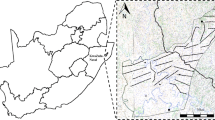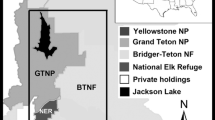Abstract
In the Serengeti National Park, Tanzania, large fluctuations of prey abundance alters the frequency at which spotted hyena (Crocuta crocuta) cubs are nursed and thus the total level of maternal input available to them. Maternal input is high when mothers feed on high densities of locally available migratory herbivores and low when mothers travel up to 70 km to forage. Using data from 19 cub cohorts on the incidence of siblicide (from monitoring the survival of 609 cubs in twin litters) and cub growth rates (from 195 cubs in twin litters) as a measure of maternal input, we demonstrate that the incidence of siblicide increased as average cohort growth rate declined. In total, there were 37 siblicides in 384 litters (9% of litters). When both cubs were alive, total maternal input in siblicidal litters was significantly lower than in non-siblicidal litters and the mean share of the dominant sib of 64.6% was significantly higher than the mean of 52.1% for dominant sibs of non-siblicidal litters. After siblicide, growth rates of siblicide victors substantially increased, demonstrating that mothers did not reduce maternal input after litter reduction. As a result, siblicide victors achieved a long-term growth rate similar to that of singletons and thus significantly increased their expected survival. We conclude that in spotted hyenas, high maternal input in lactation has favoured the evolution of facultative siblicide in populations inhabiting areas with low or fluctuating food resources.






Similar content being viewed by others
References
Bautista A, Drummond H, Martínez-Gómez M, Hudson R (2003) Thermal benefit of sibling presence in the newborn rabbit. Dev Psychobiol 43:208–215
Bautista A, García-Torres E, Martínez-Gómez M, Hudson R (2007) Do newborn domestic rabbits Oryctolagus cuniculus compete for thermally advantageous positions in the litter huddle? Behav Ecol Sociobiol DOI 10.1007/s00265-007-0420-4
Conover WJ (1980) Practical nonparametric statistics, 2nd edn. Wiley, New York
Cytel (2005) StatXact 7.0. Cytel, Cambridge, MA
Drake A, Fraser D, Weary DM (2007) Parent–offspring resource allocation in domestic pigs. Behav Ecol Sociobiol DOI 10.1007/s00265-007-0418-y
Drummond H (2001) A revaluation of the role of food in broodmate aggression. Anim Behav 61:517–526
East ML, Hofer H (2002) Conflict and co-operation in a female-dominated society: a re-assessment of the “hyper-aggressive” image of spotted hyenas (Crocuta crocuta). Adv Study Behav 31:1–30
East ML, Hofer H, Türk A (1989) Function of birth dens in spotted hyaenas (Crocuta crocuta). J Zool, Lond 219:690–697
East ML, Hofer H, Wickler W (1993) The erect penis is a flag of submission in a female-dominated society: greeting ceremonies in Serengeti spotted hyaenas. Behav Ecol Sociobiol 33:355–370
East ML, Hofer H, Cox JH, Wulle U, Wiik H, Pitra C (2001) Regular exposure to rabies virus and lack of symptomatic disease in Serengeti spotted hyenas. Proc Natl Acad Sci USA 98:15026–15031
East ML, Moestl K, Benetka V, Pitra C, Höner OP, Wachter B, Hofer H (2004) Coronavirus infection of spotted hyenas in the Serengeti ecosystem. Vet Microbiol 102:1–9
Fey K, Trillmich F (2007) Sibling competition in guinea pigs (Cavia aperea f. porcellus): scrambling for mother’s teats is stressful. Behav Ecol Sociobiol DOI 10.1007/s00265-007-0419-x
Forbes LS (1993) Avian brood reduction and parent-offspring “conflict”. Am Nat 142:82–117
Forbes LS, Ydenberg RC (1992) Sibling rivalry in a variable environment. Theor Popul Biol 41:135–160
Frank LG (1996) Female masculinization in the spotted hyena: endocrinology, behavioral ecology, and evolution. In: Gittleman SE (ed) Carnivore behavior, ecology, and evolution, vol. 2. Cornell Univ. Press, Ithaca, pp 78–131
Frank LG, Glickman SE, Licht P (1991) Fatal sibling aggression, precocial development, and androgens in neonatal spotted hyaenas. Science 252:702–704
Fraser D (1990) Behavioural perspectives on piglet survival. J Reprod Fertil 40(Suppl):355–373
Golla W, Hofer H, East ML (1999) Within-litter aggression in spotted hyaenas: effect of maternal nursing, sex and age. Anim Behav 58:715–726
Goymann W, East ML, Wachter B, Höner OP, Möstl E, Van’t Hof TJ, Hofer H (2001) Social, state-dependent and environmental modulation of faecal corticosteriod levels in free-ranging female spotted hyenas. Proc R Soc Lond B 268:2453–2459
Haas L, Hofer H, East M, Wohlsein P, Liess B, Barrett T (1996) Canine distemper virus infection in Serengeti spotted hyenas. Vet Microbiol 49:147–152
Hamilton WD (1964) The genetical evolution of social behavior. I, II. J Theor Biol 7:1–52
Hofer H, East ML (1993a) The commuting system of Serengeti spotted hyaenas: how a predator copes with migratory prey. I. Social organization. Anim Behav 46:547–557
Hofer H, East ML (1993b) The commuting system of Serengeti spotted hyaenas: how a predator copes with migratory prey. II. Intrusion pressure and commuters’ space use. Anim Behav 46:559–574
Hofer H, East ML (1993c) The commuting system of Serengeti spotted hyaenas: how a predator copes with migratory prey. III. Attendance and maternal care. Anim Behav 46:575–589
Hofer H, East ML (1995) Population dynamics, population size, and the commuting system of Serengeti spotted hyaenas. In: Sinclair ARE, Arcese P (eds) Serengeti II. Dynamics, management, and conservation of an ecosystem. University of Chicago Press, Chicago, pp 332–363
Hofer H, East ML (1997) Skewed offspring sex ratios and sex composition of twin litters in Serengeti spotted hyaenas (Crocuta crocuta) are a consequence of siblicide. Appl Anim Behav Sci 51:307–316
Hofer H, East ML (2003) Behavioural processes and costs of co-existence in female spotted hyenas: a life history perspective. Evol Ecol 17:315–331
Hofer H, East ML, Campbell KLI (1993) Snares, commuting hyaenas and migratory herbivores: humans as predators in the Serengeti. Symp Zool Soc Lond 65:347–366
Hudson R, Trillmich F (2007) Sibling competition and cooperation in mammals: challenges, developments and prospects. Behav Ecol Sociobiol DOI 10.1007/s00265-007-0417-z
James WH, Hofer H (1999) A note on sex ratios and sex combinations in Serengeti spotted hyena: siblicide and sub-binomial variance. Appl Anim Behav Sci 65:153–158
Kruuk H (1972) The spotted hyena. A study of predation and social behavior. University of Chicago Press, Chicago
McNamara JM, Houston AI, Webb JN (1994) Dynamic kin selection. Proc R Soc Lond B258:23–28
Mock DW, Parker GA (1997) The evolution of sibling rivalry. Oxford Univ. Press, Oxford
Parker GA, Mock DW, Lamey TC (1989) How selfish should stronger sibs be? Am Nat 133:846–868
Pond CM (1977) The significance of lactation in the evolution of mammals. Evolution 31:177–199
Pournelle GH (1965) Observations on the birth and early development of the spotted hyaena. J Mammal 46:503–503
Roff DA (2002) Life history evolution. Sinauer, Sunderland, VT
Smale L, Holekamp KE, White PA (1999) Siblicide revisited in the spotted hyaena: does it conform to obligate or facultative models? Anim Behav 58:545–551
Sokal RR, Rohlf FJ (1981) Biometry, 2nd edn. Freeman, San Francisco
Stearns SC (1992) The evolution of life histories. Oxford Univ. Press, Oxford
Stockley P, Parker GA (2002) Life history consequences of mammal sibling rivalry. Proc Natl Acad Sci USA 99:12932–12937
Trillmich F, Wolf JBW (2007) Parent-offspring and sibling conflict in Galápagos fur seals and sea lions. Behav Ecol Sociobiol DOI 10.1007/s00265-007-0423-1
Wachter B, Höner OP, East ML, Golla W, Hofer H (2002) Low aggression levels and unbiased ratios in a prey-rich environment: no evidence of siblicide in Ngorongoro spotted hyenas (Crocuta crocuta). Behav Ecol Sociobiol 52:348–356
Wahaj SA, Holekamp KE (2006) Function of sibling aggression in the spotted hyaena. Anim Behav 71:1401–1409
White PA (2005) Maternal rank is not correlated with cub survival in the spotted hyena, Crocuta crocuta. Behav Ecol 16:606–613
White PA (2007) Maternal response to neonatal sibling conflict in the spotted hyena, Crocuta crocuta. Behav Ecol Sociobiol DOI 10.1007/s00265-007-0422-2
Wilkinson L (2004) SYSTAT 11. SPSS, Chicago
Acknowledgements
We are grateful to the Tanzania Commission of Science and Technology and the Government of Tanzania for permission to conduct the study, the director generals of the Tanzania Wildlife Research Institute and Tanzania National Parks for cooperation and support, the Leibniz Institute of Zoo and Wildlife Research, the Fritz-Thyssen-Stiftung, the Stifterverband der deutschen Wissenschaft and the Max-Planck-Gesellschaft the for financial assistance, two anonymous referees for their helpful comments and Annie Francis, Traudi Golla, Oliver Höner, Thomas Shabani, Dagmar Thierer, Agnes Türk, Bettina Wachter and Kerstin Wilhelm for assistance.
Author information
Authors and Affiliations
Corresponding author
Additional information
Communicated by A. Schulte-Hostedde
This contribution is part of the special issue “Sibling competition and cooperation in mammals” (guest editors: Robyn Hudson and Fritz Trillmich).
Rights and permissions
About this article
Cite this article
Hofer, H., East, M.L. Siblicide in Serengeti spotted hyenas: a long-term study of maternal input and cub survival. Behav Ecol Sociobiol 62, 341–351 (2008). https://doi.org/10.1007/s00265-007-0421-3
Received:
Revised:
Accepted:
Published:
Issue Date:
DOI: https://doi.org/10.1007/s00265-007-0421-3




